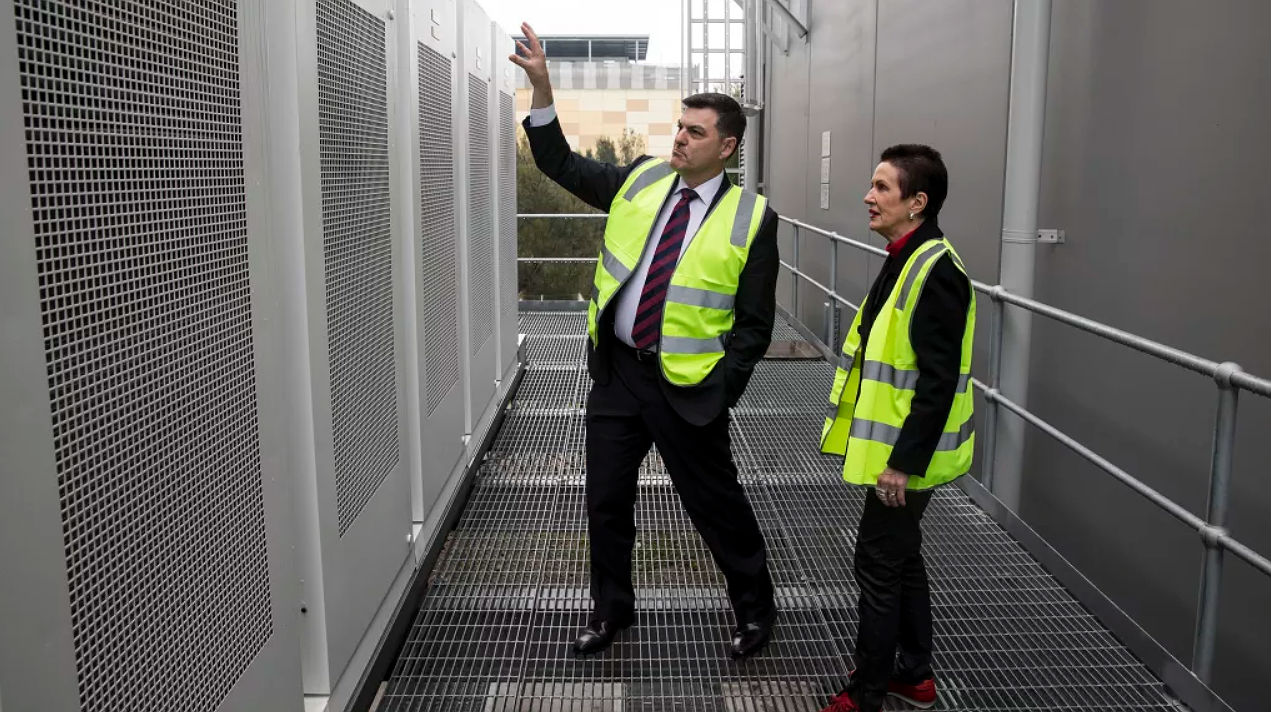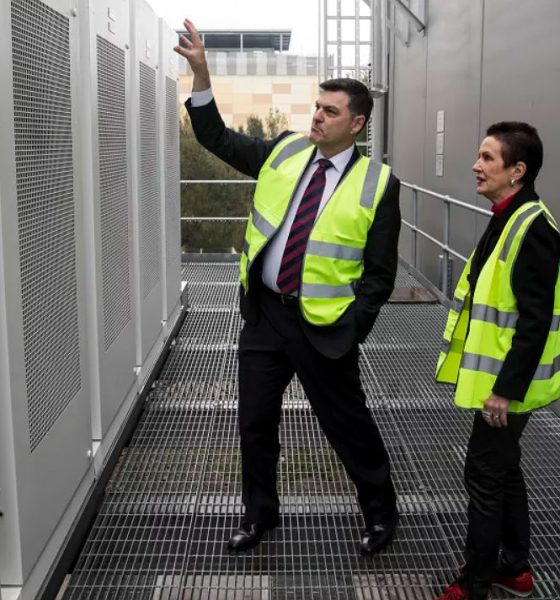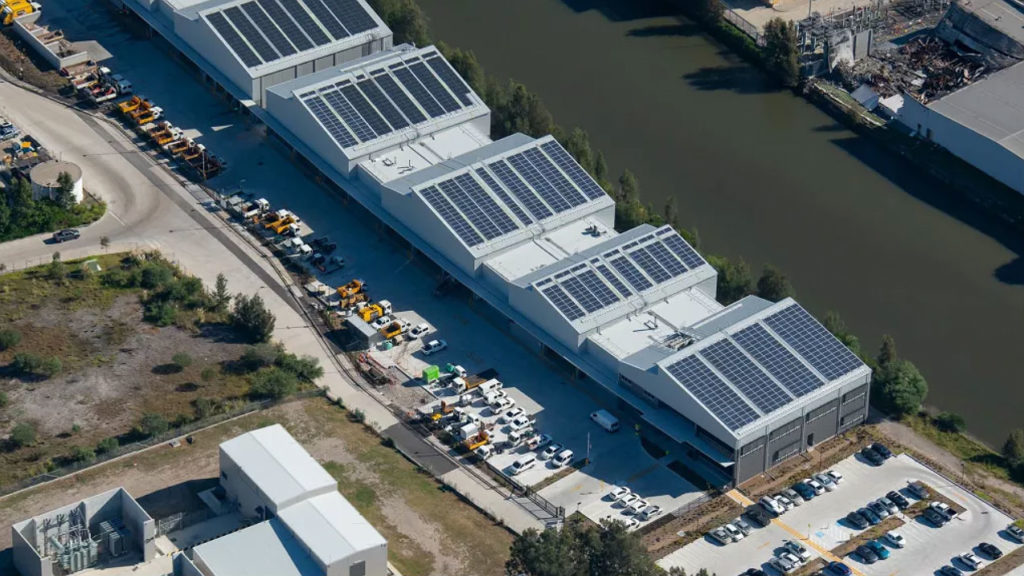

Energy
Tesla aids Sydney’s 50% renewable energy goal with new Powerpack installation
Tesla’a industrial-grade Powerpack batteries have been deployed on Sydney’s new renewable energy project at the Alexandra Canal transport depot. The installation, comprised of 1,600 solar panels and a 500 KWh Tesla Powerpack battery system, was opened by Lord Mayor Clover Moore on Wednesday.
The Alexandra Canal transport depot system is part of Sydney’s ongoing initiative to power half the city with renewable energy. In a statement to The Sydney Morning Herald, the Lord mayor stated that there are other, similar projects in the pipeline.
“We’re working towards a target of 50% of all electricity in the City of Sydney area to come from renewables by 2030. To help us achieve that target, we’re covering the roofs of our properties with as many solar panels as possible. By mid-2021, we expect to have more than 7800 solar panels on the roofs of our properties (approximately 1.5 MWh of battery storage across the city’s buildings). As the mix of storage and generation on our electricity grid changes, solar solutions like this could provide reliability and resilience to our electricity network and potentially prevent blackouts,” she said.
As an added note, Lord Mayor Moore stated that with the system in place, the Alexandra Canal transport depot could be classified as a carbon-neutral facility, saving roughly ~600 tonnes in carbon dioxide emissions per year.
Just like the immensely successful Tesla Powerpack farm near Jamestown in South Australia, the Alexandra Canal system will be tasked to provide backup power to the depot as necessary, allowing the facility to reduce its demand on the grid during peak times. The usage of the solar panels and Powerpack batteries are set to be remotely managed in real-time by TransGrid, a local electricity transmission group which awarded the Alexandra Canal transport depot contract to the Elon Musk-led company last year. In a statement to the publication, TransGrid chief executive Paul Italiano stated that large-scale batteries such as Tesla’s Powerpacks would be playing a more prominent role in Sydney’s energy network in the years to come.
“This initiative with the City of Sydney will afford the depot a significant amount of energy self-sufficiency while also sharing benefits with the wider community through the electricity network,” he said.
While Tesla’s energy business recently saw the closure of 12 solar facilities across the United States as part of the company’s ongoing workforce restructuring, the company’s energy projects continue to gain ground abroad. As noted by Elon Musk, Tesla Energy has approximately 11,000 ongoing projects in Puerto Rico, where the company continues to help the island nation get back on their feet after getting ravaged by Hurricane Maria last year. Tesla was also involved in providing stable electricity for the first time in a remote area in the Philippines.
Tesla’s Powerpacks are starting to become the battery storage solution of choice for high-profile businesses across the globe as well. Earlier this year, Manchester Science Partnerships (MSP), one of the UK’s most prominent science and technology park operators, opted to install Powerpacks on its headquarters. In the Middle East, Bee’ah CEO Khaled Al Huraimel noted that their upcoming, futuristic, headquarters in Sharjah would also be using Tesla Powerpack batteries, together with a fleet of 50 Tesla Semis for their everyday operations.
After the successful rollout of the 129 MWh Powerpack farm in South Australia, Victoria, another state in the country, has also pursued a contract with the Elon Musk-led company to install a 20 MWh Powerpack system. A massive 650 MWh virtual power plant for South Australia, comprised of solar panels and Tesla Powerwall 2 batteries installed in 50,000 homes, has also begun the first phase of its rollout.
Earlier this month, Tesla CTO JB Straubel noted that the company has been able to deploy 1 GWh worth of energy projects to date. During the 2018 Annual Shareholder Meeting, CEO Elon Musk stated that Tesla would “do another Gigawatt project” within the next 12 months, with the rate of stationary storage deployment exponentially growing every year.
“For many years to come, each incremental year will be about as much as all the preceding years, which is a crazy, crazy growth rate,” Musk said.

Cybertruck
Tesla updates Cybertruck owners about key Powershare feature

Tesla is updating Cybertruck owners on its timeline of a massive feature that has yet to ship: Powershare with Powerwall.
Powershare is a bidirectional charging feature exclusive to Cybertruck, which allows the vehicle’s battery to act as a portable power source for homes, appliances, tools, other EVs, and more. It was announced in late 2023 as part of Tesla’s push into vehicle-to-everything energy sharing, and acting as a giant portable charger is the main advantage, as it can provide backup power during outages.
Cybertruck’s Powershare system supports both vehicle-to-load (V2L) and vehicle-to-home (V2H), making it flexible and well-rounded for a variety of applications.
However, even though the feature was promised with Cybertruck, it has yet to be shipped to vehicles. Tesla communicated with owners through email recently regarding Powershare with Powerwall, which essentially has the pickup act as an extended battery.
Powerwall discharge would be prioritized before tapping into the truck’s larger pack.
However, Tesla is still working on getting the feature out to owners, an email said:
“We’re writing to let you know that the Powershare with Powerwall feature is still in development and is now scheduled for release in mid-2026.
This new release date gives us additional time to design and test this feature, ensuring its ability to communicate and optimize energy sharing between your vehicle and many configurations and generations of Powerwall. We are also using this time to develop additional Powershare features that will help us continue to accelerate the world’s transition to sustainable energy.”
Owners have expressed some real disappointment in Tesla’s continuous delays in releasing the feature, as it was expected to be released by late 2024, but now has been pushed back several times to mid-2026, according to the email.
Foundation Series Cybertruck buyers paid extra, expecting the feature to be rolled out with their vehicle upon pickup.
Cybertruck’s Lead Engineer, Wes Morrill, even commented on the holdup:
As a Cybertruck owner who also has Powerwall, I empathize with the disappointed comments.
To their credit, the team has delivered powershare functionality to Cybertruck customers who otherwise have no backup with development of the powershare gateway. As well as those with solar…
— Wes (@wmorrill3) December 12, 2025
He said that “it turned out to be much harder than anticipated to make powershare work seamlessly with existing Powerwalls through existing wall connectors. Two grid-forming devices need to negotiate who will form and who will follow, depending on the state of charge of each, and they need to do this without a network and through multiple generations of hardware, and test and validate this process through rigorous certifications to ensure grid safety.”
It’s nice to see the transparency, but it is justified for some Cybertruck owners to feel like they’ve been bait-and-switched.
Energy
Tesla starts hiring efforts for Texas Megafactory
Tesla’s Brookshire site is expected to produce 10,000 Megapacks annually, equal to 40 gigawatt hours of energy storage.

Tesla has officially begun hiring for its new $200 million Megafactory in Brookshire, Texas, a manufacturing hub expected to employ 1,500 people by 2028. The facility, which will build Tesla’s grid-scale Megapack batteries, is part of the company’s growing energy storage footprint.
Tesla’s hiring efforts for the Texas Megafactory are hinted at by the job openings currently active on the company’s Careers website.
Tesla’s Texas Megafactory
Tesla’s Brookshire site is expected to produce 10,000 Megapacks annually, equal to 40 gigawatt hours of energy storage, similar to the Lathrop Megafactory in California. Tesla’s Careers website currently lists over 30 job openings for the site, from engineers, welders, and project managers. Each of the openings is listed for Brookshire, Texas.
The company has leased two buildings in Empire West Business Park, with over $194 million in combined property and equipment investment. Tesla’s agreement with Waller County includes a 60% property tax abatement, contingent on meeting employment benchmarks: 375 jobs by 2026, 750 by 2027, and 1,500 by 2028, as noted in a report from the Houston Business Journal. Tesla is required to employ at least 1,500 workers in the facility through the rest of the 10-year abatement period.
Tesla’s clean energy boom
City officials have stated that Tesla’s arrival marks a turning point for the Texas city, as it highlights a shift from logistics to advanced clean energy manufacturing. Ramiro Bautista from Brookshire’s economic development office, highlighted this in a comment to the Journal.
“(Tesla) has great-paying jobs. Not just that, but the advanced manufacturing (and) clean energy is coming to the area,” he said. “So it’s not just your normal logistics manufacturing. This is advanced manufacturing coming to this area, and this brings a different type of job and investment into the local economy.”
Energy
Tesla and Samsung SDI in talks over new US battery storage deal: report
The update was related by industry sources and initially reported by South Korean news outlets.

Recent reports have suggested that Tesla and Samsung SDI are in talks over a potential partnership to supply batteries for large-scale energy storage systems (ESS).
The update was related by industry sources and initially reported by South Korean news outlets.
ESS batteries to be built at Samsung’s Indiana plant
As noted in a report from Korea JoongAng Daily, the demand for energy storage systems has been growing rapidly in North America, thanks in no small part to the surge in AI investments across numerous companies. With this in mind, Tesla has reportedly approached Samsung SDI about a potential battery supply deal.
The deal is reportedly worth over 3 trillion Korean won (approximately $2.11 billion) and will span three years, according to The Korea Global Economic Daily. A battery supply deal with Samsung SDI could make sense for Tesla as the company already has a grid-scale battery, the Megapack, which is perfect for industrial use. Samsung SDI could simply supply cells for the EV maker.
Production of the batteries would reportedly take place at Samsung SDI’s joint venture factory with Stellantis in Indiana, which is currently under construction. Samsung SDI recently announced plans to use part of that plant’s EV lines to produce cells for ESS, with a targeted capacity of 30 GWh by the end of next year.
Tesla and Samsung’s partnership
At present, only a handful of manufacturers, including Korea’s LG Energy Solution, Samsung SDI, SK On, and Japan’s Panasonic, are capable of producing energy storage-scale batteries domestically in the United States. A Samsung SDI official issued a comment about the matter, stating, “Nothing has been finalized regarding cooperation with Tesla.”
The possible energy storage system deal adds another layer to Tesla’s growing collaboration with Samsung, which is already in line as a partner in the upcoming production of Tesla’s AI5 and AI6 chips. Early sample manufacturing of the AI6 is expected to begin in South Korea, with mass production slated for Samsung’s Texas-based Taylor foundry when it starts operations.
The AI6 chip will power Tesla’s next wave of high-volume projects, including the Optimus humanoid robot and the autonomous Cybercab service. Musk has called the partnership with Samsung a “real collaboration,” adding that he personally plans to “walk the line” at the Taylor facility to speed up progress.









